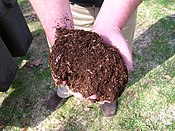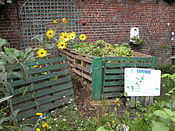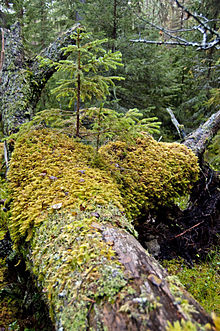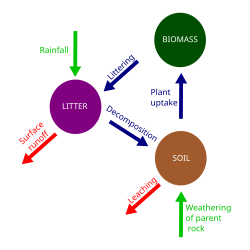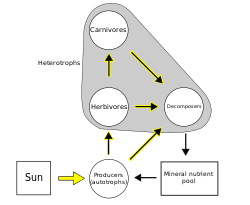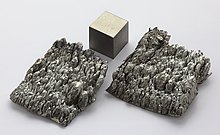Multiple rows of trees and shrubs, as well as a native grass strip, combine in a riparian buffer to protect Bear Creek in Story County, Iowa, United States.
Nature-based solutions (NBS) refers to the sustainable management and use of nature for tackling socio-environmental challenges. The challenges include issues such as climate change, water security, water pollution, food security, human health, and disaster risk management.
A definition by the European Union
states that these solutions are "inspired and supported by nature,
which are cost-effective, simultaneously provide environmental, social
and economic benefits and help build resilience. The Nature-based Solutions Initiative
meanwhile defines them as "actions that work with and enhance nature so
as to help people adapt to change and disasters". Such solutions bring
more, and more diverse, nature and natural features and processes into
cities, landscapes and seascapes, through locally adapted,
resource-efficient and systemic interventions". With NBS, healthy, resilient and diverse ecosystems (whether natural, managed or newly created) can provide solutions for the benefit of societies and overall biodiversity.
For instance, the restoration or protection of mangroves
along coastlines utilizes a nature-based solution to accomplish several
things. Mangroves moderate the impact of waves and wind on coastal
settlements or cities and sequester CO2. . They also provide
safe nurseries for marine life that can be the basis for sustaining
populations of fish that local populations may depend on. Additionally,
the mangrove forests can help control coastal erosion resulting from sea
level rise. Similarly, in cities green roofs or walls are nature-based solutions that can be used to moderate the impact of high temperatures, capture storm water, abate pollution, and act as carbon sinks, while enhancing biodiversity.
Conservation approaches and environment management initiatives
have been carried out for decades. What is new is that the benefits of
such nature-based solutions to human well-being have been articulated
well more recently. Even if the term itself is still being framed,
examples of nature-based solutions can be found all over the world, and
imitated. Nature-based solutions are on their way to being mainstreamed
in national and international policies and programmes (e.g. climate
change policy, law, infrastructure investment and financing mechanisms). For example, the theme for World Water Day 2018 was "Nature for water" and by UN-Water's accompanying UN World Water Development Report had the title "Nature-based Solutions for Water".
Background
Chicago City Hall green roof
Construction sample of a green roof system
Mangroves protect coastlines against erosion (Cape Coral, Florida, United States)
Coastal habitat protection at Morro Strand State Beach in San Luis Obispo County, California
Constructed wetland for wastewater treatment at an ecological housing estate in Flintenbreite, Germany
Societies increasingly face challenges such as climate change, urbanization, jeopardized food security and water resource provision, and disaster risk.
One approach to answer these challenges is to singularly rely on
technological strategies. An alternative approach is to manage the (socio-)ecological systems
in a comprehensive way in order to sustain and potentially increase the
delivery of ecosystem services to humans. In this context, nature-based
solutions (NBS) have recently been put forward by practitioners and
quickly thereafter by policymakers. These solutions stress the sustainable use of nature in solving coupled environmental-social-economic challenges.
While ecosystem services
are often valued in terms of immediate benefits to human well-being and
economy, NBS focus on the benefits to people and the environment
itself, to allow for sustainable solutions that are able to respond to
environmental change and hazards
in the long-term. NBS go beyond the traditional biodiversity
conservation and management principles by "re-focusing" the debate on
humans and specifically integrating societal factors such as human
well-being and poverty reduction, socio-economic development, and governance principles.
With respect to water issues, NBS can achieve the following, according to the World Water Development Report 2018 by UN-Water:
- Use natural processes to enhance water availability (e.g., soil moisture retention, groundwater recharge),
- Improve water quality (e.g., natural wetlands and constructed wetlands to treat wastewater, riparian buffer strips), and
- Reduce risks associated with water‐related disasters and climate change (e.g., floodplain restoration, green roofs).
Related concepts
In 2015, the European network BiodivERsA highlighted how NBS relate to concepts like ecosystem approaches and ecological engineering. NBS are strongly connected to ideas such as natural systems agriculture, natural solutions, ecosystem-based approaches, adaptation services, natural infrastructure, green infrastructure and ecological engineering. For instance, ecosystem-based approaches are increasingly promoted for climate change adaptation and mitigation by organisations like United Nations Environment Programme and non-governmental organisations such as The Nature Conservancy.
These organisations refer to "policies and measures that take into
account the role of ecosystem services in reducing the vulnerability of
society to climate change, in a multi-sectoral and multi-scale
approach".
Likewise, natural infrastructure is defined as a "strategically
planned and managed network of natural lands, such as forests and
wetlands, working landscapes, and other open spaces that conserves or
enhances ecosystem values and functions and provides associated benefits
to human populations"; and green infrastructure
refers to an "interconnected network of green spaces that conserves
natural systems and provides assorted benefits to human populations".
Similarly, the concept of ecological engineering
generally refers to "protecting, restoring (i.e. ecosystem restoration)
or modifying ecological systems to increase the quantity, quality and
sustainability of particular services they provide, or to build new
ecological systems that provide services that would otherwise be
provided through more conventional engineering, based on non-renewable
resources".
Definitions
The
International Union for the Conservation of Nature (IUCN) defines NBS
as actions to protect, sustainably manage, and restore natural or
modified ecosystems, that address societal challenges effectively and
adaptively, simultaneously providing human well-being and biodiversity
benefits,[15]
with climate change, food security, disaster risks, water security,
social and economic development as well as human health being the common
societal challenges.
Categories
IUCN proposes to consider NBS as an umbrella concept. Categories and examples of NBS approaches according to IUCN include:
| Category of NBS approaches | Examples |
| Ecosystem restoration approaches | Ecological restoration; Ecological engineering; Forest landscape restoration |
| Issue-specific ecosystem-related approaches | Ecosystem-based adaptation; Ecosystem-based mitigation; Climate adaptation services; Ecosystem-based disaster risk reduction |
| Infrastructure-related approaches | Natural infrastructure; Green infrastructure |
| Ecosystem-based management approaches | Integrated coastal zone management; Integrated water resources management |
| Ecosystem protection approaches | Area-based conservation approaches including protected area management |
Objectives and framing
The general objective of NBS is clear, namely the sustainable management and use of nature for tackling societal challenges. However, different stakeholders view NBS from other perspectives. For instance, IUCN
defines NBS as "actions to protect, sustainably manage and restore
natural or modified ecosystems, which address societal challenges
effectively and adaptively, while simultaneously providing human
well-being and biodiversity benefits". This framing puts the need for
well-managed and restored ecosystems at the heart of NBS, with the
overarching goal of "Supporting the achievement of society's development
goals and safeguard human well-being in ways that reflect cultural and
societal values and enhance the resilience of ecosystems, their capacity
for renewal and the provision of services".
In the context of the ongoing political debate on jobs and growth
(main drivers of the current EU policy agenda), the European Commission
underlines that NBS can transform environmental and societal challenges
into innovation opportunities, by turning natural capital into a source for green growth and sustainable development.
In their view, NBS to societal challenges are "solutions that are
inspired and supported by nature, which are cost-effective,
simultaneously provide environmental, social and economic benefits and
help build resilience. Such solutions bring more, and more diverse,
nature and natural features and processes into cities, landscapes and
seascapes, through locally adapted, resource-efficient and systemic
interventions."
This framing is somewhat broader, and puts economy and social
assets at the heart of NBS as importantly as sustaining environmental
conditions. It shares similarities with the definition proposed by Maes
and Jacobs (2015)
defining NBS as "any transition to a use of ES with decreased input of
non-renewable natural capital and increased investment in renewable
natural processes". In their view, development and evaluation of NBS
spans three basic requirements: (1) decrease of fossil fuel input per
produced unit; (2) lowering of systemic trade-offs and increasing
synergies between ES; and (3) increasing labor input and jobs. Here,
nature is seen as a tool to inspire more systemic solutions to societal
problems.
Whatever definition used, promoting sustainability and the increased role of natural, self-sustained processes relying on biodiversity,
are inherent to NBS. They constitute actions easily seen as positive
for a wide range of stakeholders, as they bring about benefits at
environmental, economic and social levels. As a consequence, the concept
of NBS is gaining acceptance outside the conservation community (e.g.
urban planning) and is now on its way to be mainstreamed into policies
and programmes (climate change policy, law, infrastructure investment
and financing mechanisms).
Types
Schematic presentation of the NBS typology.
In 2014-2015, the European network BiodivERsA mobilized a range of
scientists, research donors and stakeholders and proposed a typology
characterizing NBS along two gradients.
1. "how much engineering of biodiversity and ecosystems is involved in
NBS", and 2. "how many ecosystem services and stakeholder groups are
targeted by a given NBS". The typology highlights that NBS can involve
very different actions on ecosystems (from protection to management and
even creation of new ecosystems) and is based on the assumption that the
higher the number of services and stakeholder groups targeted, the
lower the capacity to maximize the delivery of each service and
simultaneously fulfil the specific needs of all stakeholder groups. As
such, three types of NBS are distinguished (Figure 2):
Type 1 – Minimal intervention in ecosystems
Type
1 NBS consists of no or minimal intervention in ecosystems, with the
objectives of maintaining or improving the delivery of a range of ES
both inside and outside of these conserved ecosystems. Examples include
the protection of mangroves in coastal areas to limit risks associated
to extreme weather conditions and provide benefits and opportunities to
local populations; and the establishment of marine protected areas to
conserve biodiversity within these areas while exporting biomass into
fishing grounds. This type of NBS is connected to, for example, the
concept of biosphere reserves
which incorporates core protected areas for nature conservation and
buffer zones and transition areas where people live and work in a
sustainable way.
Type 2 – Some interventions in ecosystems and landscapes
Type
2 NBS corresponds to management approaches that develop sustainable and
multifunctional ecosystems and landscapes (extensively or intensively
managed). These types improve the delivery of selected ES compared to
what would be obtained with a more conventional intervention. Examples
include innovative planning of agricultural landscapes to increase their
multi-functionality; and approaches for enhancing tree species and
genetic diversity to increase forest resilience to extreme events. This
type of NBS is strongly connected to concepts like natural systems
agriculture, agro-ecology, and evolutionary-orientated forestry.
Type 3 – Managing ecosystems in extensive ways
Type
3 NBS consists of managing ecosystems in very extensive ways or even
creating new ecosystems (e.g., artificial ecosystems with new
assemblages of organisms for green roofs and walls to mitigate city
warming and clean polluted air). Type 3 is linked to concepts like green
and blue infrastructures and objectives like restoration of heavily
degraded or polluted areas and greening cities.
Type 1 and 2 would typically fall within the IUCN NBS framework,
whereas Type 2 and moreover Type 3 are often exemplified by EC for
turning natural capital into a source for green growth and sustainable
development.
Hybrid solutions
Hybrid
solutions exist along this gradient both in space and time. For
instance, at landscape scale, mixing protected and managed areas could
be needed to fulfil multi-functionality and sustainability goals.
Similarly, a constructed wetland can be developed as a type 3 but, when well established, may subsequently be preserved and surveyed as a type 1.
Examples
Demonstrating
the benefits of nature and healthy ecosystems and showcasing the return
on investment they can offer is necessary in order to increase
awareness, but also to provide support and guidance on how to implement
NBS. A large number of initiatives around the world already highlight
the effectiveness of NBS approaches to address a wide range of societal
challenges.
India
East Kolkata wetlands
In 2018, The Hindu reported that the East Kolkata wetlands,
the world's largest organic sewage treatment facility had been used to
clean the sewage of Kolkata in an organic manner by using algae for
several decades. In use since the 1930s, the natural system was
discovered by Dhrubajyoti Ghosh, an ecologist and a municipal engineer
in the 1970s while working in the region. Ghosh worked for decades to protect the wetlands. It had been a practice in Kolkata, one of the five largest cities in India, for the municipal authorities to pump sewage into shallow ponds (bheris).
Under the heat of the tropical sun, algae proliferated in them,
converting the sewage into clean water, which in turn was used by
villagers to grow paddy and vegetables. This system has been in use in
the region since the 1930s and treats 750 million litres of wastewater per day, giving livelihood to 100,000 people in the vicinity. For his work, Ghosh was included in the UN Global 500 Roll of Honour in 1990 and received the Luc Hoffmann award in 2016.
Practical implementation
There is currently no accepted basis on which a government agency,
municipality or private company can systematically assess the
efficiency, effectiveness and sustainability of a particular
nature-based solution. However, a series of principles are proposed to
guide effective and appropriate implementation, and thus to upscale NBS
in practice. For example, NBS embrace and are not meant to replace
nature conservation norms. Also, NBS are determined by site-specific
natural and cultural contexts that include traditional, local and
scientific knowledge. NBS are an integral part of the overall design of
policies, and measure or actions, to address a specific challenges.
Finally, NBS can be implemented alone or in an integrated manner with
other solutions to societal challenges (e.g. technological and
engineering solutions) and they are applied at the landscape scale.
Implementing NBS requires political, economic, and scientific
challenges to be tackled. First and foremost, private sector investment
is needed, not to replace but to supplement traditional sources of
capital such as public funding or philanthropy.
The challenge is therefore to provide a robust evidence base for the
contribution of nature to economic growth and jobs, and to demonstrate
the economic viability of these solutions – compared to technological
ones – on a timescale compatible with that of global change.
Furthermore, it requires measures like adaptation of economic subsidy
schemes, and the creation of opportunities for conservation finance,
to name a few. Indeed, such measures will be needed to scale up NBS
interventions, and strengthen their impact in mitigating the world's
most pressing challenges.
Projects supported by the European Union
Since
2016, the EU is supporting a multi-stakeholder dialogue platform
(called ThinkNature) to promote the co-design, testing and deployment of
improved and innovative NBS in an integrated way. Creation of such science-policy-business-society interfaces could promote the market uptake of NBS.
The project is part of the EU’s Horizon 2020 – Research and Innovation
programme, and will last for 3 years. There are a total of 17
international partners involved, including the Technical University of
Crete (Project Leader), the University of Helsinki and BiodivERsA.
In 2017, as part of the Presidency of the Estonian Republic of the Council of the European Union,
a conference called “Nature-based Solutions: From Innovation to
Common-use” was organized by the Ministry of the Environment of Estonia
and the University of Tallinn.
This conference aimed to strengthen synergies among various recent
initiatives and programs related to NBS launched by the European
Commission and by the EU Member States, focusing on policy and
governance of NBS, and on research and innovation.
Nature-based Solutions in the Paris Agreement
In recognition of the importance of natural ecosystems for mitigation and adaptation, the Paris Agreement
calls on all Parties to acknowledge “the importance of the conservation
and enhancement, as appropriate, of sinks and reservoirs of the
greenhouse gases” and to “note the importance of ensuring the integrity
of all ecosystems, including oceans, and the protection of biodiversity,
recognized by some cultures as Mother Earth”. It then includes in its
Articles several references to nature-based solutions. For example,
Article 5.2 encourages Parties to adopt “…policy approaches and positive
incentives for activities relating to reducing emissions from deforestation and forest degradation,
and the role of conservation and sustainable management of forests and
enhancement of forest carbon stocks in developing countries; and
alternative policy approaches, such as joint mitigation and adaptation
approaches for the integral and sustainable management of forests, while
reaffirming the importance of incentivizing, as appropriate, non-carbon
benefits associated with such approaches”. Article 7.1 further
encourages Parties to build the resilience of socioeconomic and
ecological systems, including through economic diversification and
sustainable management of natural resources. In total, the Agreement
refers to nature (ecosystems, natural resources, forests) in 13 distinct
places. An in-depth analysis of all Nationally Determined Contributions
submitted to UNFCCC, revealed that around 130 NDCs or 65% of
signatories commit to nature-based solutions in their climate pledges,
suggesting broad consensus for the role of nature in helping meet
climate change goals. However, high-level commitments rarely translate
into robust, measurable actions on-the-ground.
History
The term NBS was put forward by practitioners in the late 2000s (in particular the International Union for the Conservation of Nature and the World Bank) and thereafter by policymakers in Europe (most notably the European Commission).
The term "nature-based solutions" was first used in the late 2000s.
It was used in the context of finding new solutions to mitigate and
adapt to climate change effects, whilst simultaneously protecting
biodiversity and improving sustainable livelihoods.
The IUCN referred to NBS in a position paper for the United Nations Framework Convention on Climate Change. The term was also adopted by European policymakers, in particular by the European Commission in a report
stressing that NBS can offer innovative means to create jobs and growth
as part of a green economy. The term started to make appearances in the
mainstream media around the time of the Global Climate Action Summit in
California in September 2018








